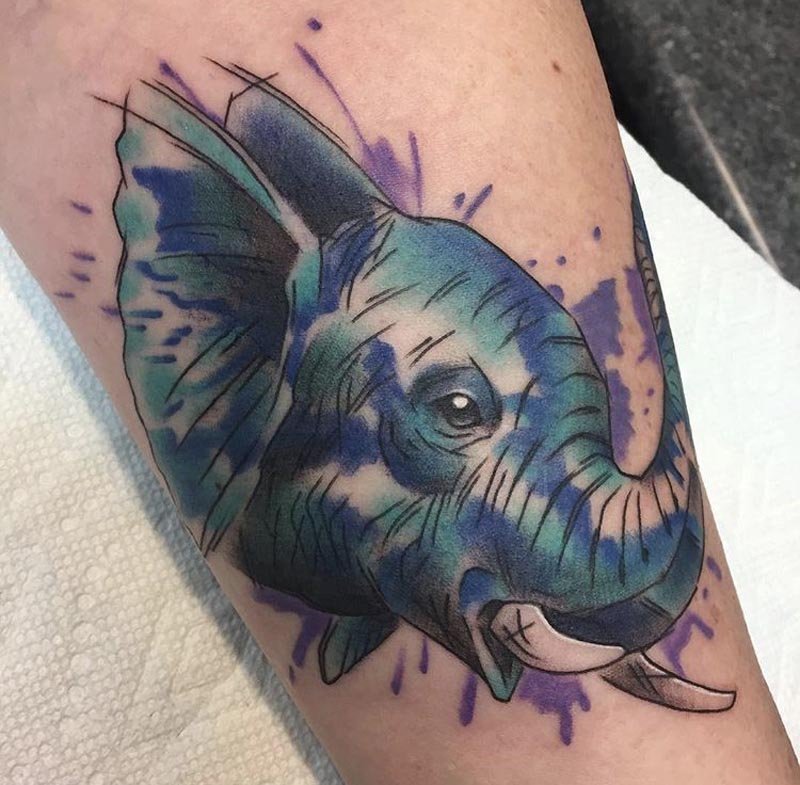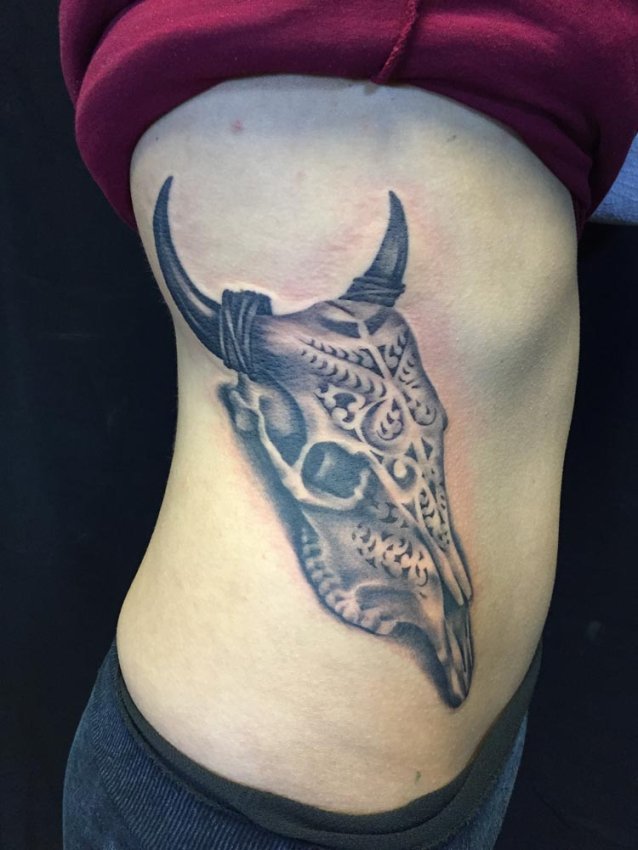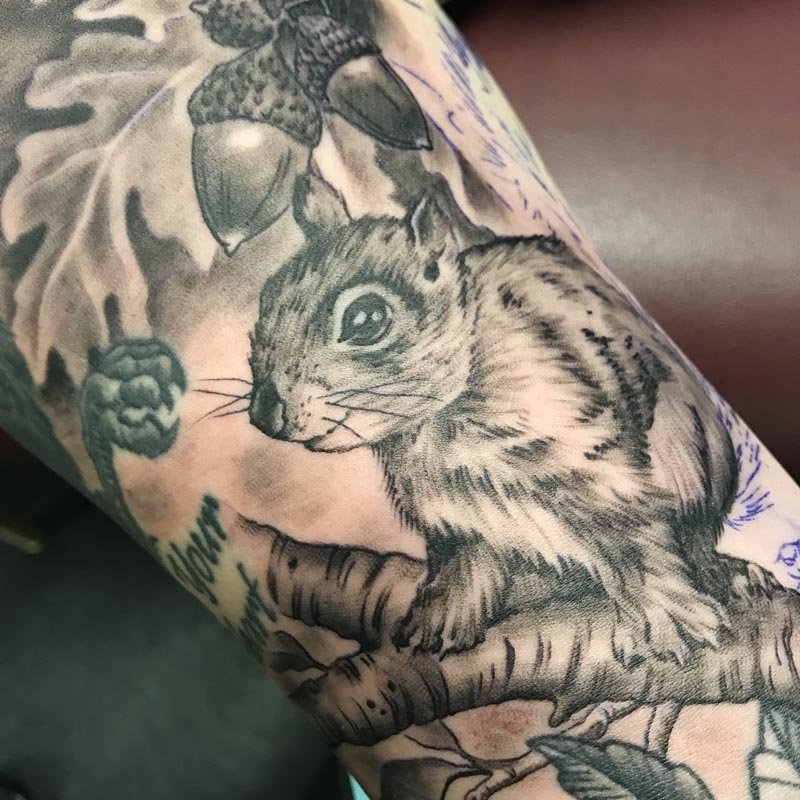Hailing from the heart of the Midwest, near the Indiana Dunes, Drew Thomas knows what it’s like to get his hands dirty.
The area I grew up in was working class. My family all worked in the steel mills, so they had a really strong work ethic. People there like to work a lot, but then they also like to have fun.
That meant a lot of fishing, boating, skateboarding, and, surprisingly, art.
When I was growing up, my dad used to draw and paint a lot. He was an electrician at the steel mill. But when he was at home, he spent a lot of time painting landscapes, pencil drawings, decorative paintings, you name it. Art just became something I naturally gravitated to—maybe not super well—but I grew up drawing a lot.
Drew will tell you he was no Picasso, but he spent hours sketching nature, landscapes, birds, and horses and later shifted to the mechanical marvels of race cars and airplanes. So, when did Drew take the leap from his sketch pad to skin?
Before I even got my art degree, I had exposure to professional tattooing and what it was like to be a tattoo artist because a good friend of mine at art school started tattooing.
It really gave me a look at the ins and outs of tattooing, how the business operated, and what the environment was like. I got to hear about those things firsthand.
Intrigued, Drew thought he would try his hand at tattooing, not really thinking it would be a lifelong career.
When I first started tattooing, I thought it was something I would try out for a little until I had more of an idea of what I wanted to do with my life. But as I started to do it, I became enthralled with the process—the history behind tattooing, the challenges of trying to figure it all out. Then I started noticing that more and more people could earn a living tattooing. And, for me, it just naturally turned into a lifelong career.
So, did Drew have a formal apprenticeship? Nah. Remember this was the mid-90s. Tattooing was a renegade activity, light years away from what people thought was a traditional art career path.
I got a hold of some equipment and started tattooing friends, relatives, and well wishers. I was a rogue tattooer for a year or so before I put a portfolio together. Then, I went to tattoo shops in Chicago and found a place to work.
Working in a busy street shop allowed Drew to tattoo every style imaginable.
Pretty much every style came my way. So, I knew if I was going to do well, I needed to learn about different styles and what elements of a tattoo were necessary for each of those styles.
Drew instinctively carried over his illustrative style and branched out from there, adding a unique touch to the tattoos he created.
I went into tattooing with an illustrative, comic book-type style of drawing. That grew to a graffiti-type style. My tattoos didn't have an outline, just a lot more soft shading and subtle variations. Working in a busy shop challenged me to create tattoos that looked great regardless of the style, and it expanded my artistic vocabulary.
These days, Drew enjoys creating realistic black and gray renderings of subjects, perhaps a nod to his childhood. His tattoo style leans towards intricate line work and dark, subtle shading, but he still enjoys mixing it up.
I often say that my natural style isn't Realism; it's "real-ish." I like doing things that don't look exactly like a photograph but have a very three-dimensional look with a bit more emphasis on contrast and outline.
A stellar example of Drew's ability to master this style is the bear tattoo he created. It’s in his portfolio. Ask to take a look at it. You'll be blown away. The bear has very textured fur along with extremely defined features, almost taking on a line look. It's tattoos like this that Drew feels stand up to the test of time.
Crisp lines and contrasts between surfaces hold up nicely over time.
And, if Drew can tell his clients anything, it would be to think long-term when choosing a tattoo design. That, and be realistic on the scale of the tattoo.
Tattoo art has evolved to a point where almost anything is possible—any image and almost any amount of detail. But, you've got to remember the medium—skin—has its limits because it's not a high-resolution surface, it's more organic. As the tattoo and skin ages, you can only retain a certain amount of detail over time. People may want an incredibly detailed tattoo, but they may want it too small. That just won't hold up long term. It's important to figure out how much area the tattoo will cover and how much detail can be put into that area.
In other words, when you see a detailed picture online or a fresh tattoo, you can't take that to mean the scale is always possible. A skilled tattoo artist can tell you if it can be done and how it will hold up; trust them.
A good tattoo isn't just about doing a great piece of artwork; it's also about working with a client to provide exceptional service and attempt to understand what they want.
It's my job as a tattoo artist to help them design the tattoo so it looks great years from now.
All these years later, it’s interacting with his clients and sharing knowledge that Drew still loves. Well, that and creating jaw-dropping tattoos.
I really enjoy doing tattoos for people because I know that they're going to look at them down the road and think, 'Wow, that's a great tattoo.' The best part about tattooing is the fact that I'm able to create a piece of artwork for somebody that will be enjoyed for the rest of that person's life.
It’s a pretty good feeling for Drew—making a living doing what he loves. And, he’s grateful to have the opportunity to continue his work with a diverse client base in a lively city.
When I moved to Nashville, I wanted to work in a shop that was really vibrant and high-energy. I wanted to be in the lively Nashville downtown area. I checked out different shops, but Hart & Huntington really stood out.
H&H instantly left a lasting impression on Drew, as it does with most people.
I was surprised by how comfortable it was, how nice the space felt, and how friendly the staff was.
I felt instantly welcomed, and I really liked the feeling that I got when I walked into Hart & Huntington.
Drew continues to be impressed with H&H, from the process when clients come in that make the artists' life much easier to the incredible talent in the shop.
The artists can concentrate fully on what they're supposed to be doing. The staff is just excellent to work with, they help people narrow down and decide what they want to convey with a tattoo. Then, they share that information with the artists. It's a seamless process. And, a big group of really skilled artists.







